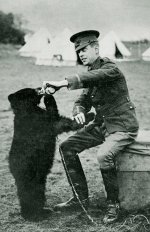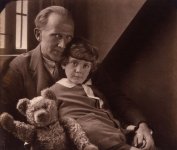PolarBear
Major
- Joined
- Feb 24, 2007
- Messages
- 6,706
World War I & Winnie the Pooh
From Wikipedia
Harry Colebourn (April 12, 1887 – September 24, 1947)
Early life
Harry Colebourn was born in England and emigrated to Canada when he was 18. He attended the Ontario Veterinary College, receiving his degree in Veterinary surgery, and moved west to Winnipeg, Manitoba.
Winnie and World War I
As he was heading across Canada by train to the training camp at Valcartier, Quebec where he was to embark for overseas duty during World War I, Colebourn came across a hunter in White River, Ontario who had a female black bear cub for sale. The hunter had killed the cub's mother and sold the cub to Colebourn for $20. Colebourn named her "Winnie," after his adopted hometown, and took her across the Atlantic with him to Salisbury Plain, where she became an unofficial mascot of The Fort Garry Horse, a Militia cavalry regiment. Colebourn himself was a member of the Canadian Army Veterinary Corps, attached to the Fort Garry Horse as a veterinarian. While Colebourn served three years in France, attaining the rank of major, he kept Winnie at the London Zoo to whom he eventually donated her.
It was at the London Zoo that A.A. Milne and his son Christopher Robin Milne encountered Winnie. Christopher was so taken with her that he named his teddy bear after her, which became the inspiration for Milne's fictional character in the books Winnie-the-Pooh 1926 and The House at Pooh Corner 1928. Milne also included several poems about Winnie-the-Pooh in the children’s poetry books When We Were Very Young and Now We Are Six. All four volumes were illustrated by E. H. Shepard. Winnie would stay at the zoo until she died in 1934.
From Wikipedia
Harry Colebourn (April 12, 1887 – September 24, 1947)
Early life
Harry Colebourn was born in England and emigrated to Canada when he was 18. He attended the Ontario Veterinary College, receiving his degree in Veterinary surgery, and moved west to Winnipeg, Manitoba.
Winnie and World War I
As he was heading across Canada by train to the training camp at Valcartier, Quebec where he was to embark for overseas duty during World War I, Colebourn came across a hunter in White River, Ontario who had a female black bear cub for sale. The hunter had killed the cub's mother and sold the cub to Colebourn for $20. Colebourn named her "Winnie," after his adopted hometown, and took her across the Atlantic with him to Salisbury Plain, where she became an unofficial mascot of The Fort Garry Horse, a Militia cavalry regiment. Colebourn himself was a member of the Canadian Army Veterinary Corps, attached to the Fort Garry Horse as a veterinarian. While Colebourn served three years in France, attaining the rank of major, he kept Winnie at the London Zoo to whom he eventually donated her.
It was at the London Zoo that A.A. Milne and his son Christopher Robin Milne encountered Winnie. Christopher was so taken with her that he named his teddy bear after her, which became the inspiration for Milne's fictional character in the books Winnie-the-Pooh 1926 and The House at Pooh Corner 1928. Milne also included several poems about Winnie-the-Pooh in the children’s poetry books When We Were Very Young and Now We Are Six. All four volumes were illustrated by E. H. Shepard. Winnie would stay at the zoo until she died in 1934.



